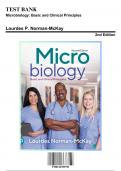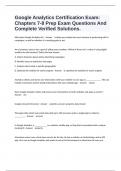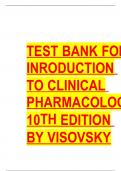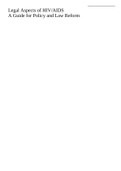Lourdes P. Norman-McKay
TEST BANK
Microbiology: Basic and Clinical Principles
2nd Edition
9780136785750 Table of content
Chapter 1 Introduction to Microbiology
Chapter 2 Biochemistry Basics
Chapter 3 Introduction to Prokaryotic Cells
Chapter 4 Introduction to Eukaryotic Cells
Chapter 5 Genetics
Chapter 6 Viruses and Prions
Chapter 7 Fundamentals of Microbial Growth and Decontamination
Chapter 8 Microbial Metabolism
Chapter 9 Principles of Infectious Disease and Epidemiology
Chapter 10 Host-Microbe Interactions and Pathogenesis
Chapter 11 Innate Immunity
Chapter 12 Adaptive Immunity
Chapter 13 Immune System Disorders
Chapter 14 Biomedical Applications: Vaccines, Diagnostics, Therapeutics, and
Molecular Methods
Chapter 15 Antimicrobial Drugs
Chapter 16 Respiratory System Infections
Chapter 17 Skin and Eye Infections
Chapter 18 Nervous System Infections
Chapter 19 Digestive System Infections
Chapter 20 Urinary and Reproductive System Infections
Chapter 21 Cardiovascular and Lymphatic Infections Microbiology: Basic & Clinical Principles, 2e (Norman-McKay)
Chapter 1 Introduction to Microbiology
1.1 Multiple Choice Questions
1) Which of the following is not a microorganism?
A) bacteria
B) archaea
C) fungi
D) mosquito
E) helminth
Answer: D
Chapter/Section: 1.1
Learning Outcome: 1.1
Bloom's Taxonomy: 1-2: Remembering/Understanding
2) When do opportunistic pathogens tend to cause disease?
A) when the host is weakened
B) when the host has recently traveled to a remote area
C) when the host is young
D) when the host is pregnant
E) when the host didn't wash with soap
Answer: A
Chapter/Section: 1.1
Learning Outcome: 1.2
Bloom's Taxonomy: 1-2: Remembering/Understanding
3) Which of the following could be used as evidence for spontaneous generation?
A) Uncovered meat will give rise to maggots.
B) The meat in gauze-covered jars will not give rise to maggots.
C) The broth in Pasteur's S-necked flasks did not spoil.
D) Tilting Pasteur's S-necked flasks did spoil the broth.
E) Flies lay eggs that develop into maggots.
Answer: A
Chapter/Section: 1.1
Learning Outcome: 1.3
Bloom's Taxonomy: 1-2: Remembering/Understanding
1
Copyright © 2023 Pearson Education, Inc. 4) ________ showed that biogenesis is responsible for the propagation of life.
A) Louis Pasteur
B) Robert Hooke
C) Antonie van Leeuwenhoek
D) Joseph Lister
E) Carl Linnaeus
Answer: A
Chapter/Section: 1.1
Learning Outcome: 1.3
Bloom's Taxonomy: 1-2: Remembering/Understanding
5) Robert Koch helped establish the germ theory of disease by discovering that anthrax was caused by a bacterial microorganism. After he isolated and purified the same bacteria from several diseased animals, what would be the next step in order to show that this bacteria caused anthrax?
A) perform physiological testing
B) introduce the bacteria into a new mouse to see if it established the same infection
C) visualize the bacteria with an electron microscope
D) culture the bacteria on Petri dishes
E) find out if antibiotics treat the diseased animals
Answer: B
Chapter/Section: 1.1
Learning Outcome: 1.4
Bloom's Taxonomy: 1-2: Remembering/Understanding
6) How many principles are there in Koch's postulates of disease?
A) 1
B) 2
C) 3
D) 4
E) 5
Answer: D
Chapter/Section: 1.1
Learning Outcome: 1.4
Bloom's Taxonomy: 1-2: Remembering/Understanding
7) Aseptic technique can be used for all of the following except
A) preventing healthcare-acquired infections.
B) safely studying microbes in the laboratory.
C) keeping samples pure for studying.
D) replacing gloves instead of hand washing when time is short.
E) limiting the spread of diseases.
Answer: D
Chapter/Section: 1.1
Learning Outcome: 1.5
Bloom's Taxonomy: 1-2: Remembering/Understanding
2
Copyright © 2023 Pearson Education, Inc. 8) Which of the following individuals does not correctly match with their contribution to microbiology?
A) Ignaz Semmelweis: First developed aseptic techniques to decrease mortality rates from childbed fever
B) Joseph Lister: Developed the first anesthetic solution for use in surgeries
C) Florence Nightingale: Established the use of aseptic techniques in nursing practices
D) Robert Koch: Developed criteria for determining the causative agent of an infectious disease
E) Louis Pasteur: Showed that biogenesis is responsible for the propagation of life
Answer: B
Chapter/Section: 1.1
Learning Outcome: 1.6
Global LO: G2
Bloom's Taxonomy: 3-4: Applying/Analyzing
9) The scientific method starts with a(n)
A) hypothesis.
B) prediction.
C) observation.
D) question.
E) proposal.
Answer: D
Chapter/Section: 1.1
Learning Outcome: 1.7
Global LO: G1
Bloom's Taxonomy: 1-2: Remembering/Understanding
10) Inference-observation confusion occurs when someone
A) jumps to a conclusion.
B) cannot understand your accent.
C) remembers events wrong.
D) lies about what happened.
E) incorrectly assesses a patient.
Answer: A
Chapter/Section: 1.1
Learning Outcome: 1.7
Global LO: G1 | G2
Bloom's Taxonomy: 3-4: Applying/Analyzing
3
Copyright © 2023 Pearson Education, Inc. 11) ________ predict what happens, while ________ explain how and why something occurs.
A) Theories; laws
B) Hypotheses; conclusions
C) Laws; theories
D) Observations; hypotheses
E) Observations; conclusions
Answer: C
Chapter/Section: 1.1
Learning Outcome: 1.7
Global LO: G1
Bloom's Taxonomy: 1-2: Remembering/Understanding
12) Which of the following is the correct way to type a scientific name?
A) escherichia coli
B) Escherichia Coli
C) escherichia coli
D) Escherichia coli
E) Escherichia coli
Answer: D
Chapter/Section: 1.2
Learning Outcome: 1.10
Bloom's Taxonomy: 1-2: Remembering/Understanding
13) What is the order of the taxonomic hierarchy from least specific to most specific?
A) species, genus, order, family, class, phylum, kingdom, domain
B) domain, kingdom, phylum, class, order, family, genus, species
C) class, order, phylum, kingdom, domain, genus, family, species
D) domain, phylum, order, kingdom, class, family, genus, species
E) domain, order, class, kingdom, phylum, species, family, genus
Answer: B
Chapter/Section: 1.2
Learning Outcome: 1.8
Bloom's Taxonomy: 1-2: Remembering/Understanding
14) All of the following are reasons to classify a new strain of bacteria except
A) mutations.
B) gene transfers.
C) take up genetic material from their environment.
D) 50% different genetic material.
E) genetic variant.
Answer: D
Chapter/Section: 1.2
Learning Outcome: 1.9
Bloom's Taxonomy: 1-2: Remembering/Understanding
4
Copyright © 2023 Pearson Education, Inc. 15) Why can't prokaryotic species be defined as a group of similar organisms that could sexually reproduce together?
A) Bacteria reproduce asexually.
B) Bacteria are all too different to be considered similar.
C) The mating rituals of bacteria have not been studied enough.
D) They can be.
E) We can't see them in enough detail to tell how similar they really are yet.
Answer: A
Chapter/Section: 1.2
Learning Outcome: 1.8 | 1.10
ASM LO: 1.4
Bloom's Taxonomy: 1-2: Remembering/Understanding
16) Normal microbiota are responsible for all of the following except
A) training our immune system.
B) producing vitamins for us.
C) helping us digest foods.
D) inducing spontaneous mutations in our genome.
E) impacting our moods and brain functions.
Answer: D
Chapter/Section: 1.2
Learning Outcome: 1.12
ASM LO: 5.4
Bloom's Taxonomy: 1-2: Remembering/Understanding
17) Which of the following does not contribute to shifts in our normal microbiota?
A) hormonal changes
B) diet
C) age
D) proper hand-washing technique
E) our general environment
Answer: D
Chapter/Section: 1.2
Learning Outcome: 1.12
ASM LO: 5.4
Bloom's Taxonomy: 1-2: Remembering/Understanding
5
Copyright © 2023 Pearson Education, Inc. 18) Microbes and humans have evolved a variety of ________ relationships, including ________
where microbes help the host.
A) commensal; mutualism
B) symbiotic; parasitism
C) symbiotic; commensalism
D) dynamic; commensalism
E) symbiotic; mutualism
Answer: E
Chapter/Section: 1.2
Learning Outcome: 1.11
ASM LO: 5.4
Bloom's Taxonomy: 1-2: Remembering/Understanding
19) Carriers of the sickle-cell gene
A) are more likely to die from a malaria infection.
B) are more susceptible to contracting malaria.
C) have a survival advantage in areas where malaria is common.
D) are often found in high concentrations in U.S. cities.
E) experience painful changes in nerve cell shape.
Answer: C
Chapter/Section: 1.2
Learning Outcome: 1.13
Bloom's Taxonomy: 1-2: Remembering/Understanding
20) Which of the following is true about bioremediation?
A) Bioremediation never harms the environment.
B) Bioremediation will use genetically-modified organisms to break down the chemicals found in the spill zone.
C) The Environmental Protection Agency documents a handful of chemical spills per year in the United States alone.
D) Antibiotics are used to seed the spill zone to prevent growth of unwanted microbial species.
E) Nitrogen, sulfur, phosphate, and sometimes iron supplements are added to the spill zone to encourage microbial growth.
Answer: E
Chapter/Section: 1.2
Learning Outcome: 1.15
ASM LO: 6.3
Bloom's Taxonomy: 1-2: Remembering/Understanding
6
Copyright © 2023 Pearson Education, Inc. 21) All of the following are or can be produced by microbes except
A) food like chocolate.
B) drugs like penicillin.
C) consumer products like biodegradable plastics.
D) electronics like computer memory.
E) biofuels like diesel.
Answer: D
Chapter/Section: 1.2
Learning Outcome: 1.15
ASM LO: 6.3
Bloom's Taxonomy: 1-2: Remembering/Understanding
22) All of the following may involve biofilms except
A) kidney stones.
B) inner ear infections.
C) atherosclerosis.
D) endocarditis.
E) Influenza.
Answer: E
Chapter/Section: 1.2
Learning Outcome: 1.14
Global LO: G2
ASM LO: 5.2
Bloom's Taxonomy: 3-4: Applying/Analyzing
23) When ________ bacteria attach to a surface and begin to replicate, creating multiple layers, sticky communities called ________ may form.
A) planktonic; biofilms
B) pathogenic; quorums
C) plaque; microbiota
D) infectious; flora
E) matrix; cavities
Answer: A
Chapter/Section: 1.2
Learning Outcome: 1.14
ASM LO: 5.2
Bloom's Taxonomy: 1-2: Remembering/Understanding
7
Copyright © 2023 Pearson Education, Inc. 24) Which of the following statements is true?
A) Media for bacterial growth only comes in a few varieties.
B) Picking which type of media format to use depends only on the space available.
C) Picking which type of media to use depends on how much money the researcher is willing to spend.
D) Agar is used as a solidifying agent for bacterial culture media.
E) Scientists were not able to grow bacteria in the lab until the creation of the Petri dish.
Answer: D
Chapter/Section: 1.3
Learning Outcome: 1.16
Bloom's Taxonomy: 1-2: Remembering/Understanding
25) When practicing aseptic culturing techniques, it is important to keep all of the following in mind except
A) as long as nothing unintended touches the media, there will be no contamination.
B) the media used to grow the specimen is sterile.
C) all of the instruments and lab ware that directly touch the specimen is sterile.
D) surrounding surfaces are decontaminated before and after handling cultures.
E) gloves and other protecting clothing may be required depending on the specimen being used.
Answer: A
Chapter/Section: 1.3
Learning Outcome: 1.17
Bloom's Taxonomy: 1-2: Remembering/Understanding
26) A biological safety cabinet minimizes the chances of contaminating cultures by all of the following except
A) limiting access to inside the cabinet.
B) maintaining a specific flow of filtered air.
C) readily being decontaminated using UV light.
D) regular surface cleaning with an antimicrobial solution.
E) consistent flame sterilization on the inside surfaces.
Answer: E
Chapter/Section: 1.3
Learning Outcome: 1.17
Bloom's Taxonomy: 1-2: Remembering/Understanding
27) The goal of the streak plate technique is to
A) compare all of the colonies on a plate with a mixed culture.
B) visualize all of the colonies on a plate from a pure culture.
C) isolate a pure culture for study from a single colony.
D) spread out a thick layer of bacteria and isolate the bacteria that outcompete the rest.
E) compare how the shape, color, and margin differ in colonies from a pure culture.
Answer: C
Chapter/Section: 1.3
Learning Outcome: 1.18
Bloom's Taxonomy: 1-2: Remembering/Understanding
8
Copyright © 2023 Pearson Education, Inc.







